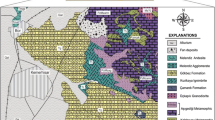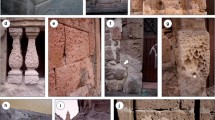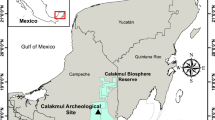Abstract
The Lyrbe, located 12 km northeast of Manavgat (Antalya), is one of the important ancient cities in the Pamphylia Province. Although the history of the city dates back to the Hellenistic period, the settlement mostly belongs to the Roman period. The agora, bath, necropolis church, temples and cisterns are partly survived structures in the city until today. The agora is the most important structure among them and composed of library, archive rooms, temple, fountain and bouleuterion. In this study, the provenance of the conglomerate and sandstone ashlars used in the construction of the Lyrbe city was investigated by analyzing and comparing the petrographic and geotechnical properties of rocks in the city structures and in the quarries. The mineralogical, textural and geotechnical properties of the rocks were obtained. In situ non-destructive test measurements were also carried out on the surface of the building’s conglomerate and sandstone ashlars together with in conglomerates and sandstones from documented quarries. The obtained results showed that the different rock samples from both the city structures and quarries have similar geological and index-mechanical properties. The results enabled to identify the provenance of the conglomerate and sandstone ashlars used in the construction of the Lyrbe city. Therefore, this study will contribute for future restoration and conservation works of the Lyrbe ancient city heritage.








Similar content being viewed by others
References
Akay E, Uysal S, Poisson A, Cravatte J, Muller C (1985) Stratigraphy of the Antalya Neogene Basin. Geol Soc Turkey Bull 28:105–119 (in Turkish with English abstract)
Al-Bashaireh K (2011) Provenance of marbles from the octagonal building at Gadara “Umm-Qais”, Northern Jordan. J Cult Herit 12(3):317–322. https://doi.org/10.1016/j.culher.2011.01.005
Antonelli F, Lazzarini L (2015) An updated petrographic and isotopic reference database for white marbles used in antiquity. Rend Lincei 26(4):399–413. https://doi.org/10.1007/s12210-015-0423-4
ASTM D5873 (2014) Standard test method for determination of rock hardness by rebound Hammer method. In: Annual book of ASTM standards. American Society for Testing and Materials, West Conshohocken
ASTM D7012 (2014) Standard test methods for compressive strength and elasticmoduli of intact rock core specimens under varying states of stress and temperatures, annual book of ASTM standards. American Society for Testing and Materials, West Conshohocken
Capedri S, Venturelli G, Photiades A (2004) Accessory minerals and δ18 O and δ13 C of marbles from the Mediterranean area. J Cult Herit 5:27–47. https://doi.org/10.1016/j.culher.2003.03.003
Carò F, Sokrithy IM (2012) Khmer sandstone quarries of Kulen Mountain and Koh Ker: a petrographic and geochemical study. J Archaeol Sci 39(5):1455–1466. https://doi.org/10.1016/j.jas.2012.01.007
Deynoux M, Çiner A, Monod O, Karabıyıkoğlu M, Manatschal G, Tuzcu S (2005) Facies architecture and depositional evolution of alluvial fan delta complexes in the tectonically active Miocene Köprüçay Basin, Isparta Angle, Turkey. Sediment Geol 173(1–4):315–343. https://doi.org/10.1016/j.sedgeo.2003.12.013
Dott RH (1964) Wacke, graywacke and matrix - what approach to immature sandstone classification? J Sediment Res 34(3):625–632. https://doi.org/10.1306/74D71109-2B21-11D7-8648000102C1865D
Folk RL (1964) Petrography of sedimentary rocks. Hemphill’s Bookstore, Austin
Garcia-Valles M, Urzì C, Vendrell-Saz M (2002) Weathering processes on the rock surface in natural outcrops: the case of an ancient marble quarry (Belevi, Turkey). Environ Geol 41(8):889–897. https://doi.org/10.1007/s00254-001-0466-y
Gökçe MV, İnce İ, Okuyucu C, Doğanay O, Fener M (2020) Ancient Isaura quarries in and around Zengibar Castle (Bozkır, Konya), Central Anatolia, Turkey. Geoheritage 12:69. https://doi.org/10.1007/s12371-020-00498-9
İnan J (1998) Toroslar’da bir antik kent. Arkeoloji ve Sanat Yayınları, İstanbul (in Turkish)
ISRM (1979) Suggested methods for determining the uniaxial compressive strength and deformability of rock materials. Int J Rock Mech Min Sci Geomech Abstr 16:135–140
ISRM (2007) The complete ISRM suggested methods for rock characterization, testing and monitoring: 1974–2006 (ed. Ulusay R, Hudson J). ISRM Turkish National Group, Ankara
Karabıyıkoğlu M, Çiner A, Monod O, Deynoux M, Tuzcu S, Örçen S (2000) Tectonosedimentary evolution of the Miocene Manavgat Basin, Western Taurids, Turkey. J Geol Soc Lond 173:475–498. https://doi.org/10.1144/GSL.SP.2000.173.01.14
Lanckoroński KG (1890) Städte Pamphyliens und Pisidiens, Pamphylien (Band: 1). Tempsky, Wien (in German)
Lecuit MX, Fronteau G, Boulvain F, Dechamps S, Eyssautier-Chuine S, Piavaux M, Yans J (2018) Geochemical characterization of “Lorraine limestones” from the Saint-Paul Cathedral of Liège (Belgium): assumptions for the true provenance of the building stones. Environ Earth Sci 77:361. https://doi.org/10.1007/s12665-018-7554-8
Martínez-Martínez J, Corbí H, Martin-Rojas I, Baeza-Carratalá JF, Giannetti A (2017) Stratigraphy, petrophysical characterization and 3D geological modelling of the historical quarry of Nueva Tabarca island (western Mediterranean): Implications on heritage conservation. Eng Geol 231:88–99. https://doi.org/10.1016/j.enggeo.2017.10.014
Melfos V (2008) Green Thessalian stone: the byzantine quarries and the use of a unique architectural material from the Larisa area, Greece. Petrographic and geochemical characterization. Oxf J Archaeol 27(4):387–405. https://doi.org/10.1111/j.1468-0092.2008.00313.x
NBG (1985) Engineering geology and rock engineering. Norwegian Group of Rock Mechanics, Fornebu
Russell B (2017) Stone quarrying in Greece: ten years of research. Archaeological Reports 63:77–88
Snethlage R (2005) Leitfaden Steinkonservierung. Fraunhofer IRB Verlag, Stuttgart
Sutherland J, Sutherland A (2002) Roman marble quarrying near Karystos Southern Euboea. J Cult Herit 4(3):251–259. https://doi.org/10.1016/S1296-2074(02)01243-8
TS EN-1925 (2000) Natural stone test methods determination of water absorption coefficient by capillarity. Turkish Standards Institution, Ankara (in Turkish)
TS EN-12407 (2019) Natural stone test methods—petrographic examination. Turkish Standards Institution, Ankara (in Turkish)
Yıldırım N (2014) Lyrbe Agorası. Dissertation, Akdeniz Üniversitesi (in Turkish with English abstract)
Acknowledgements
We are grateful to the Manavgat Municipality for providing accommodation and access to the field during this study. Two anonymous referees are gratefully acknowledged for their helpful suggestions and constructive comments on the manuscript.
Author information
Authors and Affiliations
Corresponding author
Additional information
Publisher's Note
Springer Nature remains neutral with regard to jurisdictional claims in published maps and institutional affiliations.
This article is part of a Topical Collection in Environmental Earth Sciences on “Building Stones and Geomaterials through History and Environments—from Quarry to Heritage. Insights of the Conditioning Factors”, guest edited by Siegfried Siegesmund, Luís Manuel Oliveira Sousa, and Rubén Alfonso López-Doncel.
Rights and permissions
About this article
Cite this article
Aksoy, R., İnce, İ., Mimiroğlu, İ.M. et al. Provenance and geological and geomechanical properties of building stones used in the construction of the Lyrbe ancient city (Manavgat, Antalya, Turkey). Environ Earth Sci 80, 789 (2021). https://doi.org/10.1007/s12665-021-10110-0
Received:
Accepted:
Published:
DOI: https://doi.org/10.1007/s12665-021-10110-0




